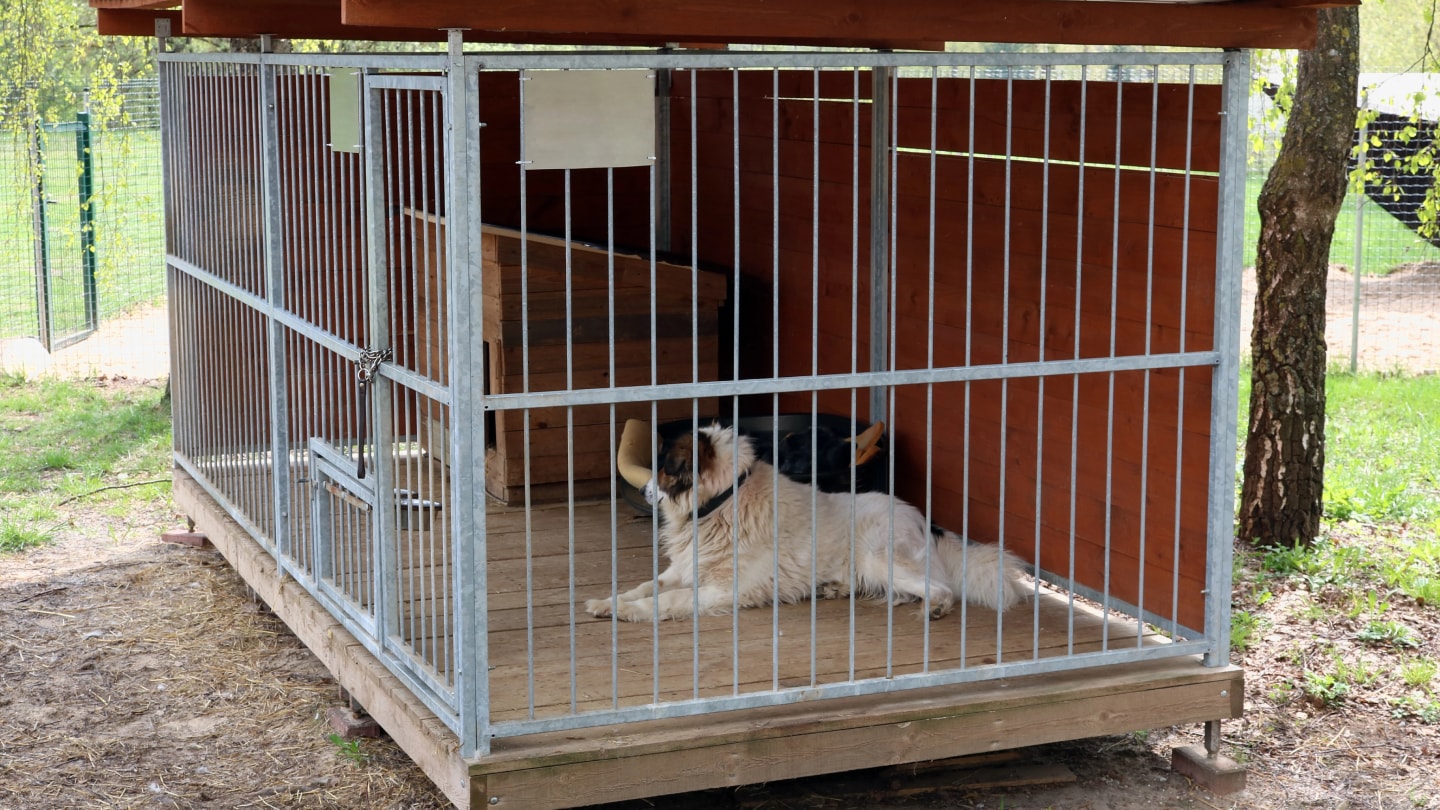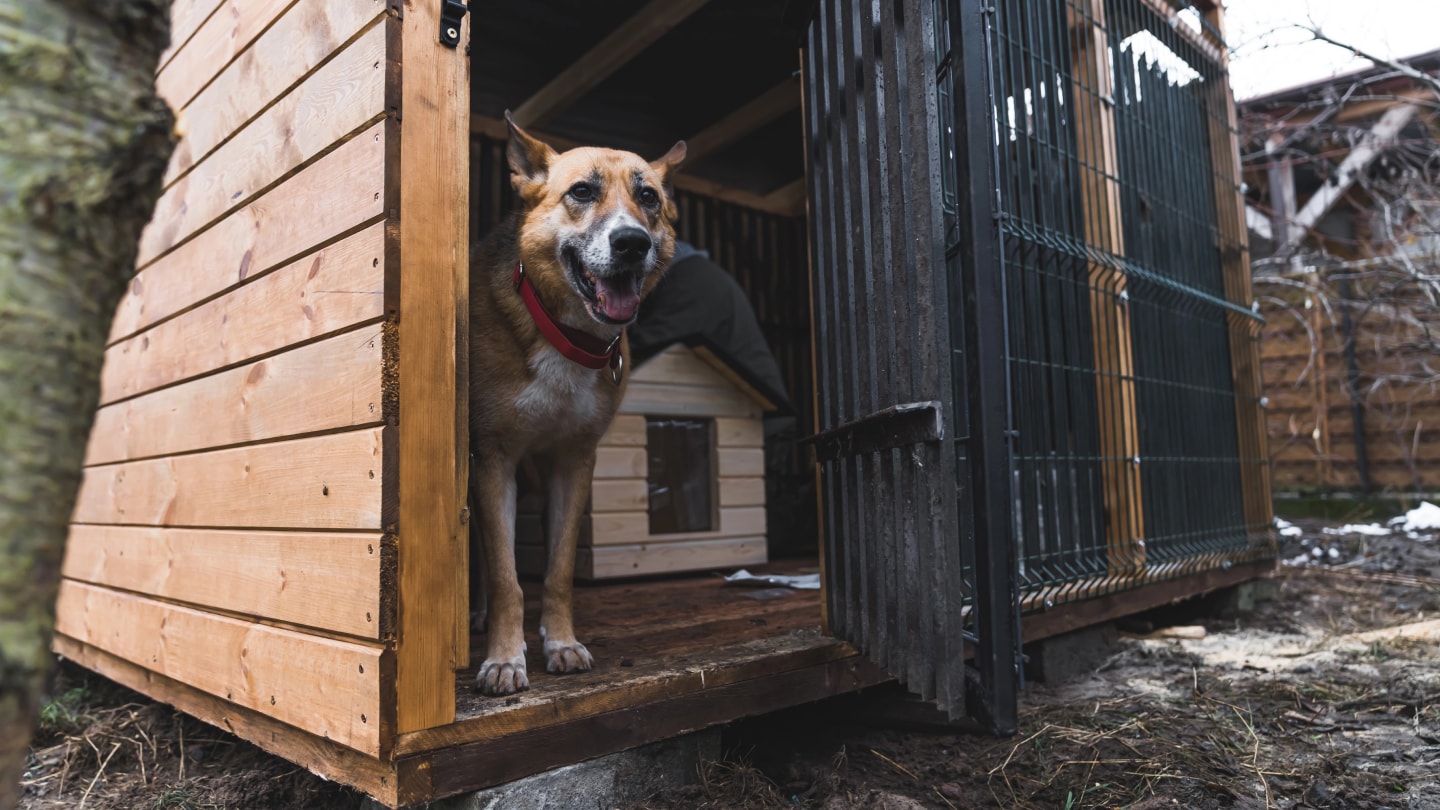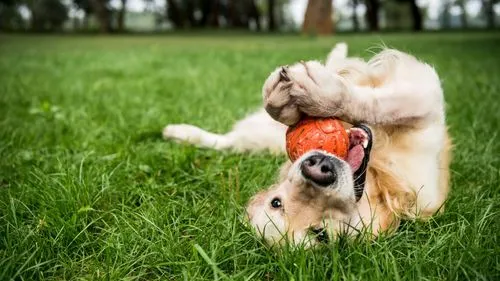When can I leave a puppy in a kennel and what should it look like?
July 23, 2025
Katka

Getting a puppy is an exciting event, but it also brings a lot of questions and responsibilities. One of the most common is: "Can I leave a puppy in a kennel?" And if so, how long can a dog be in the kennel, how big should it be, and what should be inside?
A dog kennel can be a practical solution when used sensibly. However, it is definitely not a substitute for human contact, exercise, or training. In this article, we will look at how to use a kennel properly, how to equip it, and why a dog tied to a chain is definitely not an alternative.
What is a dog kennel and when does it make sense?
A dog kennel is a fenced, safe area (most often in the garden) where a dog can stay without direct supervision. If designed correctly, it can be a refuge and a temporary resting place. It is used, for example:
- while working in the garden or during construction work,
- during the owner's short absence,
- for dogs living outside as permanent housing.
But be careful – the dog's stay in the kennel must be reasonable, and the dog should always look forward to being there. Otherwise, it can become a source of stress and frustration.
Need to leave your dog at home and worry about how it will cope? Afraid it will chew something out of loneliness or bark? Install the Barkio app to keep an eye on your buddy and notify you if something happens.

Is a dog kennel suitable for a puppy?
Yes, but with great caution. A puppy is just learning to be alone; it perceives the world more sensitively and reacts strongly to separation. A puppy's stay in the kennel should be gradual and always associated with positive experiences.
Start with a few minutes, stay nearby, reward it with treats and toys. Never leave a puppy in the kennel for hours on end without breaks or preparation.
How should a kennel for a dog look?
1. Sufficient space
For one dog, the dog kennel should be at least 6–8 m², and for larger breeds, even 10–15 m². The dog should be able to turn around, lie down, stretch out, and walk comfortably. When building for a puppy, plan with an eye on its future size.
2. Dog house
Every kennel must contain a dog house as a shelter and a place for rest. It should be:
- spacious enough but not too large (to retain heat),
- insulated or weatherproof,
- elevated off the ground (to prevent dampness and cold),
- easy to clean – for example, with a removable roof.
You can line the dog house with wood shavings or insulate it with polystyrene. Definitely do not put blankets, old clothing, or other materials inside that absorb moisture.
3. Water bowl
It may sound obvious, but it is not. Every dog in the kennel must have constant access to fresh water. An ideal is a heavy ceramic or metal bowl that the dog cannot tip over.
4. Toys and stimulation
A dog in a kennel must not be bored. Provide chew toys, interactive balls, or puzzles to keep it entertained and reduce stress.
5. Flooring and cleanliness
The flooring should be non-slip, washable (for example, rubber mats, wooden slats), and regularly cleaned of feces, leftover food, and dirt.

Where to place the kennel?
The placement of the kennel affects how the dog will feel. Ideally, it should be in a quiet part of the garden, away from roads or disturbances, partially shaded (the dog needs both shade and sun), and protected from wind, drafts, and rain.
The ideal location is within sight of the house, but not directly at the door, so the dog does not bark at every movement. At the same time, it is not recommended to place the kennel completely in a corner of the garden without contact with the surroundings – the dog would feel isolated.
How to teach a dog to use a kennel
Many owners are confronted with the question: how to teach a dog to use a kennel, or how to teach a puppy to use a kennel without causing stress or resistance. The key is positive training, correct timing, and respect for the individual needs of the pet.
Whether it’s a puppy or an adult dog, the goal is for it to perceive the kennel as a safe haven, not as punishment or isolation.
For some dogs, it may take days to weeks to get used to the kennel. That’s perfectly fine. Always follow the behavior of the particular dog – some need more time, while others take to the kennel very quickly.
🐶 How to teach a puppy to use a kennel
For puppies, the advantage is that they quickly adapt to new stimuli. If you start early and gently, the puppy can be happy and calm in the kennel.
Introduce the puppy to the kennel gradually – let it explore the space without closing it in. Add a bed, a favorite toy, and something with your scent. Start with a few minutes, ideally after feeding or a walk when it is calmer. Praise and reward it when it is calm in the kennel. Never forcibly shut the puppy in or do it as a punishment.
“Never forcibly shut the puppy in or do it as punishment.“
🐕 How to teach an adult dog to use a kennel
An adult dog may have less patience with the kennel – especially if it has had a bad experience with it. In that case, it's important to be even more consistent and sensitive.
Begin just like with a puppy – with an open kennel, food, and toys. Train in calm conditions, without disturbances. The first closing of the door should last only a few seconds, gradually lengthening it. After each "stay" in the kennel, follow it with a reward, a walk, or a shared activity. Use the kennel as a place of calm, not as a form of isolation.
⏱️ How long can a dog be in a kennel?
This question is very common – and entirely justified. How long a dog can be in a kennel depends on several factors:
- dog's age,
- health condition and temperament,
- habituation to solitude,
- weather,
- kennel equipment.
Puppy in a kennel
Up to 6 months of age:
A helpful rule of thumb is the following calculation. A puppy can be in the kennel for a maximum of as many hours as it is months old (2 months = 2 hours, 5 months = 5 hours).
Always take the puppy out to relieve itself before closing. If the kennel also serves as a night bed, plan for 1–2 night outings, depending on age.
Above 6 months
Never more than 6 hours without a break (ideally 3–4 hours). Always take it out to relieve itself before and after longer periods. Gradually move the last outing closer to morning, but still plan one night outing.
Adult dog in a kennel
A dog must not be left in the kennel all day. Always ensure access to water, shade, and the opportunity for a short outing between longer stays. The kennel should serve more as a safe space than a permanent solution for relieving itself.

How to tell if the kennel is harmful to your dog
Frequent and long barking or whining
If a puppy or dog in the kennel constantly barks, whines, or tries to escape, it may signal anxiety, frustration, or discomfort. Especially if the behavior repeats even when it isn’t hungry or needs to relieve itself.
Loss of interest in toys and food
A dog that is uncomfortable in the kennel may ignore otherwise favorite treats and toys. Instead, it displays passivity, hunching, or a crouched posture ("hunching over"), indicating stress.
Bedsores or injuries
Being kept in the kennel for too long and inappropriately (for example, a narrow space without bedding) can lead to bedsores on joints, small abrasions, or pressure sores. Regularly check the skin and coat for signs of irritation.
Reluctance to enter the kennel
When a dog runs away from the kennel entrance, hides, or stretches back out from inside, it signals that it does not associate the kennel with safety but with an unpleasant experience.
Disrupted sleep
Instead of peacefully falling asleep, the dog in the kennel constantly changes positions, paces back and forth, or wakes up. This behavior indicates that it does not feel comfortable, even during the night.
Changes in appetite and digestion
Stress from an inappropriate environment may manifest as loss of appetite, diarrhea, or, conversely, constipation. Watch for digestive issues in your dog related to being in the kennel.
What to do when you notice signs of discomfort with the kennel
- Reduce the length of the stay to a minimum based on age.
- Increase comfort – softer bedding, a familiar blanket, a favorite toy.
- Gradual acclimatization – start with a few minutes and slowly extend.
- Watch for needs – always take the dog out to relieve itself before closing it in.
- Alternatives to the kennel – open pens, baby gates in the living room, or a safe room.
This way, you ensure that the kennel will be a true refuge for your pet, not a source of stress.

❌ Can a dog be on a chain?
A topic that is still current – and also very sensitive. A dog tied to a chain is not a substitute for a kennel, and certainly not a suitable way of keeping it.
A dog tied to a chain suffers from a lack of movement and stimulation, is exposed to extreme weather without the possibility of shelter, often suffers from anxiety, aggression, or apathy, and cannot fulfill its natural needs (running, exploring, contact).
Keeping a dog on a chain for extended periods is currently considered abuse.
What does the law say?
Across North America, Europe and Australia, the law is moving the same way: leaving a dog permanently or carelessly chained is increasingly treated as animal cruelty, so modern rules demand strict time-limits, daily exercise, proper shelter, fresh water – or an outright ban on heavy chains.
In the United States, Texas’s 2022 Safe Outdoor Dogs Act—now echoed by laws in roughly half the states—bans heavy chains, demands a tether of at least 10 ft (≈ 3 m) or five times the dog’s length, and requires constant shade, shelter and water, so leaving a dog chained all day can trigger an immediate cruelty citation. SPCA of Texas THLN
In the United Kingdom, tethering is still legal, yet the Animal Welfare Act 2006 and DEFRA’s welfare code oblige owners to check tethered dogs frequently and prevent distress; courts enforce this vigorously, as shown by a March 2025 Hull case in which two offenders were banned from keeping animals for ten years.
In Australia, state regulations such as Victoria’s Code of Practice for the Tethering of Animals allow tethering only as a short-term measure and require regular inspections, shade and water—non-compliance can mean fines or the dog’s seizure.
Frequently asked questions
1. From what age can I close a puppy in a kennel?
Start the introduction immediately after bringing the puppy home (around 8 weeks), but always for a maximum of a few minutes and only with positive motivation (toy, treat, your presence).
2. How long can a puppy be in a kennel during the day?
The general rule says: "number of hours in the kennel ≈ number of months of age." Up to 6 months, so a maximum of 2–6 hours; after 6 months, ideally no longer than 3–4 hours with a break for relieving itself.
3. Can a puppy have a blanket or old clothes in the dog kennel?
Not recommended – these materials absorb moisture and can be a source of mold. Instead, use wood shavings, polystyrene inserts, or a special pad that can be easily washed.
4. What is the ideal size of a kennel for a growing puppy?
For small to medium breeds, 6–8 m² is sufficient; for larger breeds, 10–15 m². Plan from the beginning with respect to the expected adult size.
5. What to do if a dog in the dog kennel constantly barks or whines?
Reduce the stay, check for comfort (toy, fabric), and try gradual acclimatization: leave the door open, reward calm behavior, and never close forcibly.
6. What toys are most suitable for the dog kennel?
Interactive puzzles, chew toys, and sturdy balls – those that motivate sniffing or mental activities and are not easily broken.
7. Is a dog kennel suitable for the night?
Yes, if the dog house is sufficiently insulated and has a solid base. However, remember to take it out for regular night reliefs according to the age of the puppy (1–2 times a night).
Conclusion
A dog kennel can be a great place for your puppy or adult dog to rest and feel safe – if designed well, equipped, and used sensitively and gradually. The key is to ensure sufficient space, a suitable dog house, constant access to water, stimulating toys, and regular maintenance.
Never use the dog kennel as punishment or a long-term solution instead of regular walks and social interaction. Pay attention to your pet’s behavior, respect its needs, and adjust the length of stay in the kennel according to its age and habituation to solitude. By following the recommendations above, you will ensure that the kennel is a true refuge for your dog, not a source of stress.
Every dog deserves dignified treatment, attention, and love. Whether in an apartment, on a garden, or in a dog kennel – it should always know that it belongs somewhere. ❤️
Continue reading...
Show all articlesCopyright & trademark notices
Apple, the Apple logo, and iPhone are trademarks of Apple Inc., registered in the U.S. and other countries and regions. App Store is a service mark of Apple Inc. Mac App Store is a service mark of Apple Inc. Google Play and the Google Play logo are trademarks of Google LLC. Windows® and the Windows logo are either registered trademarks or trademarks of Microsoft Corporation in the United States and/or other countries. Linux® is the registered trademark of Linus Torvalds in the U.S. and other countries.


